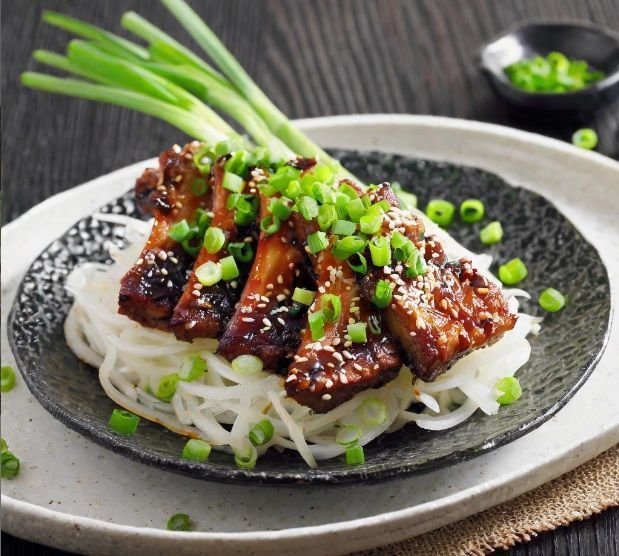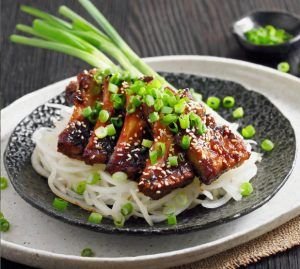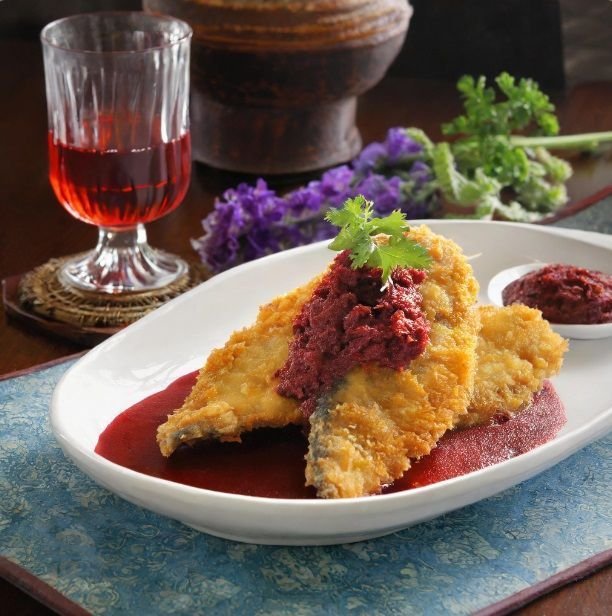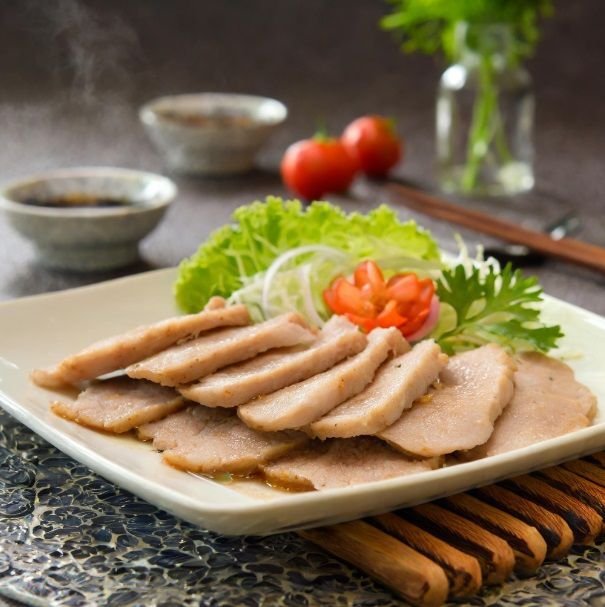Fukienese scallion beaded “spareribs”
Fukienese scallion beaded “spareribs”
Chinese recipes – Trending recipes – Asian food
Fujianese Scallion Beaded “Spareribs” is a delightful dish from East China that features tender pork ribs coated with a flavorful mixture of scallions, garlic, and other aromatic ingredients. Here’s a step-by-step recipe to make this delicious dish:
Ingredients:
For the Pork Ribs:
- 500g pork ribs, cut into bite-sized pieces
- 2 tablespoons Shaoxing wine (or dry sherry)
- 2 tablespoons soy sauce
- 1 tablespoon oyster sauce
- 1 tablespoon cornstarch
- 1 teaspoon sugar
- 1/2 teaspoon white pepper
- Vegetable oil for frying
For the Scallion Bead Coating:
- 1 cup chopped scallions (green onions)
- 3 cloves garlic, minced
- 2 tablespoons sesame oil
- 1 tablespoon soy sauce
- 1 tablespoon oyster sauce
- 1 tablespoon rice vinegar
- 1 teaspoon sugar
- 1/2 teaspoon white pepper
- 1/4 cup all-purpose flour
Instructions:
- Marinate the Pork Ribs:
- In a bowl, combine the pork ribs with Shaoxing wine, soy sauce, oyster sauce, cornstarch, sugar, and white pepper. Mix well to ensure the ribs are evenly coated. Let marinate for at least 30 minutes, or preferably overnight in the refrigerator.
- Prepare the Scallion Bead Mixture:
- In a separate bowl, combine the chopped scallions, minced garlic, sesame oil, soy sauce, oyster sauce, rice vinegar, sugar, and white pepper. Mix well to create the scallion bead mixture.
- Coat the Pork Ribs:
- Remove the marinated pork ribs from the refrigerator. Add the all-purpose flour to the scallion bead mixture and mix until it forms a thick paste-like consistency.
- Dip each marinated pork rib into the scallion bead mixture, ensuring it is thoroughly coated on all sides.
- Fry the Pork Ribs:
- Heat vegetable oil in a deep skillet or wok over medium heat. Carefully add the coated pork ribs to the hot oil, working in batches if necessary to avoid overcrowding the pan.
- Fry the pork ribs until they are golden brown and crispy on the outside, and cooked through on the inside, about 5-7 minutes per batch. Remove the fried pork ribs from the oil and drain them on paper towels.
- Serve:
- Transfer the Fujianese Scallion Beaded “Spareribs” to a serving dish. Garnish with additional chopped scallions, if desired, for a fresh burst of flavor.
- Serve hot with steamed rice or as part of a larger Chinese meal.
- Enjoy:
- Enjoy the flavorful combination of tender pork ribs coated with aromatic scallion bead mixture, a delicious specialty from Fujian Province in East China!
This Fujianese Scallion Beaded “Spareribs” recipe is sure to impress with its crispy texture, savory-sweet flavor, and aromatic scallion coating. Perfect for a family dinner or special occasion, it’s a delightful dish that showcases the culinary richness of Chinese cuisine.
Unveiling the Richness of Chinese Rice Vinegar in Culinary Delights
Introduction: Chinese rice vinegar, a beloved staple in Chinese cuisine, adds a tangy-sweet complexity to dishes, making it an indispensable ingredient in kitchens across China and beyond. In this comprehensive article, we delve into the origins, varieties, production methods, culinary uses, health benefits, and cultural significance of Chinese rice vinegar, exploring its multifaceted role in culinary delights.
1. Origins and Varieties: Chinese rice vinegar, known as “米醋” (mǐ cù) in Mandarin, has a long history dating back thousands of years. It is made through the fermentation of rice, and there are several varieties, including white rice vinegar, black rice vinegar, red rice vinegar, and aged rice vinegar. Each variety has its unique flavor profile, color, and viscosity, ranging from mild and sweet to robust and tangy.
2. Production Methods: The production of Chinese rice vinegar involves fermenting rice with specific strains of bacteria to convert the carbohydrates into acetic acid. The fermentation process can take anywhere from a few days to several years, depending on the desired flavor and acidity level. Traditional methods, such as the “solid-state fermentation” and “liquid-state fermentation” techniques, are still used to produce artisanal rice vinegars with distinctive flavors and characteristics.
3. Culinary Uses: Chinese rice vinegar is a versatile ingredient used in a wide range of dishes, from stir-fries and marinades to dressings and dipping sauces. Its tangy-sweet flavor adds depth and brightness to dishes, while its acidity helps to balance and enhance other flavors. It is commonly used in pickling, as a dipping sauce for dumplings and spring rolls, and as a key ingredient in classic dishes like sweet and sour pork and hot and sour soup.
4. Health Benefits: Chinese rice vinegar offers several health benefits, thanks to its natural fermentation process and rich nutrient profile. It is low in calories and fat, making it a healthier alternative to other condiments like mayonnaise or creamy dressings. Rice vinegar is also believed to aid digestion, regulate blood sugar levels, and promote overall well-being when consumed in moderation.
5. Cultural Significance: Chinese rice vinegar holds profound cultural significance in Chinese society, symbolizing prosperity, longevity, and the interconnectedness of nature and humanity. It is a staple ingredient in traditional rituals, such as Lunar New Year celebrations and ancestral offerings, where it is used to honor ancestors and bring blessings of abundance and good fortune.
6. Regional Variations: Different regions of China have their own unique varieties of rice vinegar, each with its distinct flavor and aroma. For example, Zhenjiang black rice vinegar from Jiangsu Province is known for its robust flavor and dark color, while Shanxi aged vinegar from Shanxi Province is prized for its mellow sweetness and complex aroma.
7. Global Influence: In recent years, Chinese rice vinegar has gained popularity beyond China’s borders, thanks to the growing interest in Asian cuisine and globalization. It is now a ubiquitous condiment found in kitchens and restaurants worldwide, where it adds an authentic Asian flavor to a variety of dishes, from salads and marinades to sauces and dressings.
8. Conclusion: In conclusion, Chinese rice vinegar stands as a testament to the rich culinary heritage and cultural diversity of China, cherished for its unique flavor, versatility, and health benefits. Whether used to add a tangy-sweet kick to stir-fries or as a pickling agent for vegetables, rice vinegar continues to captivate palates and inspire culinary creativity around the globe.
As we savor the bright acidity and subtle sweetness of Chinese rice vinegar in our favorite dishes, we honor the centuries-old tradition of craftsmanship and ingenuity that have shaped this beloved condiment into an indispensable culinary icon.





